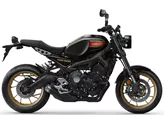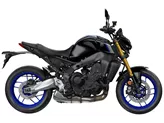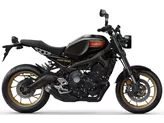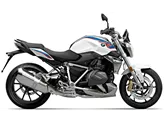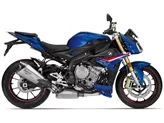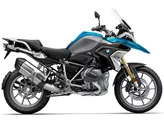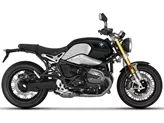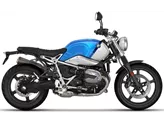BMW R 1250 R 2019 vs. Yamaha XSR900 2016

BMW R 1250 R 2019

Yamaha XSR900 2016
Overview - BMW R 1250 R 2019 vs Yamaha XSR900 2016
The BMW R 1250 R 2019 and the Yamaha XSR900 2016 are both naked bikes that offer a thrilling riding experience. However, they have several differences in terms of their technical specifications and strengths and weaknesses.
In terms of engine and drive train, the BMW R 1250 R 2019 is equipped with a powerful Boxer engine that produces 136 HP of power and 143 Nm of torque. On the other hand, the Yamaha XSR900 2016 features an in-line engine that generates 115 HP of power and 87.5 Nm of torque. The BMW R 1250 R has a larger displacement of 1254 ccm compared to the Yamaha XSR900's 847 ccm. The BMW R 1250 R has a liquid-air cooling system, while the Yamaha XSR900 has a liquid cooling system.
Both bikes have upside-down telescopic forks for the front suspension and monoshock for the rear suspension. However, the BMW R 1250 R has a single swing arm for the rear suspension, while the Yamaha XSR900 has a swing arm. The BMW R 1250 R has a steel frame, whereas the Yamaha XSR900 has an aluminum frame. The frame of the BMW R 1250 R is load-bearing, which adds to its stability.

BMW R 1250 R 2019
In terms of braking, both bikes feature double disk brakes at the front. The BMW R 1250 R has larger brake disks with a diameter of 320 mm, while the Yamaha XSR900 has brake disks with a diameter of 298 mm. Both bikes are equipped with ABS as standard.
The BMW R 1250 R 2019 offers advanced rider assistance systems such as anti-slipping control, riding modes, and ride by wire. The Yamaha XSR900 2016, on the other hand, only has ABS as an advanced rider assistance system.
In terms of dimensions and weights, both bikes have the same front and rear tire widths and diameters. However, the BMW R 1250 R has a longer wheelbase of 1515 mm compared to the Yamaha XSR900's 1440 mm. The seat height of the BMW R 1250 R is also slightly higher at 820 mm compared to the Yamaha XSR900's 815 mm. The BMW R 1250 R is heavier with a kerb weight of 239 kg, while the Yamaha XSR900 weighs 191 kg. The BMW R 1250 R also has a larger fuel tank capacity of 18 liters compared to the Yamaha XSR900's 14 liters.
In terms of strengths, the BMW R 1250 R offers a powerful boxer engine with a good sound and a comfortable seating position. It also comes with ABS and traction control as standard, along with riding modes. Additionally, it has a sporty look that appeals to riders.

Yamaha XSR900 2016
The Yamaha XSR900, on the other hand, has a greedy engine and well-tuned riding modes. It also features ABS and TC as standard and has an authentic modern design with clean workmanship.
However, the BMW R 1250 R has some weaknesses, including a long surcharge list and no visually new features. The Yamaha XSR900 has a hard chassis and a seat that could be more comfortable. Additionally, its speedblock design is already seen on many other models.
In conclusion, the BMW R 1250 R 2019 and the Yamaha XSR900 2016 are both impressive naked bikes with their own strengths and weaknesses. The BMW R 1250 R offers a more powerful engine and advanced rider assistance systems, while the Yamaha XSR900 has a unique design and well-tuned riding modes. Ultimately, the choice between these two bikes will depend on the rider's preferences and priorities.
Technical Specifications BMW R 1250 R 2019 compared to Yamaha XSR900 2016
Pros and Cons in comparison
Pros and Cons in comparison
BMW R 1250 R 2019

What could be better than getting even more power and torque in an already powerful naked bike! The predecessor, the R 1200 R, with its 125 hp and Newton metres of torque, could already be ridden very sportily, but the enlarged R 1250 R, now with 136 hp and a massive 143 Newton metres, pushes the boxer power to its current peak. The special thing about the R 1250 R, as with its predecessor, is that thanks to the extensive range of accessories it can also convince on tours. The new engine with ShiftCam valve control is not only more powerful but also more refined. The chassis and brakes are also convincing, and the seating position is pleasantly upright, allowing a wide range of riding styles, from sporty push-off to long-distance touring.
Yamaha XSR900 2016

The XSR900 combines the performance of a sporty streetfighter with the look of a pleasing, cleanly finished retro naked bike. In doing so, the Japanese make use of their own history, which can be found bundled and without gaps in the archive of the design agency that has been working for Yamaha for 60 years. It adopts the virtues of the MT-09 and has mended some of its weaknesses. It rides more harmoniously, more controlled and, if desired, more relaxed. Only the comfort, and thus the rider, suffers from the tight chassis on bad roads. You have to be a little bit sensitive when it comes to a neo-classic.
Price Comparison Avarage Market Price BMW R 1250 R vs Yamaha XSR900
There are a few key differences between a BMW R 1250 R 2019 and a Yamaha XSR900 2016. In terms of price, the actual average price of a BMW R 1250 R 2019 is about 98% higher. Compared to Yamaha XSR900 2016 there are more BMW R 1250 R 2019 bikes available on the 1000PS.de Marketplace, specifically 15 compared to 5. It takes less time to sell a Yamaha XSR900 with 77 days compared to 83 days for the BMW R 1250 R. Since model year 2019 1000PS.de editors have written 11 reviews for the BMW R 1250 R and 30 reviews for the Yamaha XSR900 since model year 2016. The first review for the BMW R 1250 R was published on 06/11/2018 and now has more than 73,800 views. This compares to more than 17,600 views for the first review on Yamaha XSR900 published on 25/11/2015.


